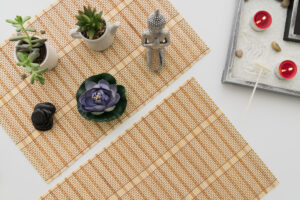Running a rugs business can be deeply rewarding. From offering stunning designs that transform spaces to helping customers find their perfect match, few industries combine functionality and artistry the way rugs do. However, like any business, it comes with unique challenges.
The rugs industry is competitive, with everything from sourcing products to managing logistics requiring careful planning. Whether you’re a small business owner just starting out or a seasoned entrepreneur looking to grow, understanding these challenges is the first step toward success.
This blog explores the common struggles of running a rugs business and offers practical solutions so you can address these head-on, scale sustainably, and meet customer needs.
1. Sourcing High-Quality Rugs
The Challenge
Rug quality is at the heart of the industry. Customers expect durability, vibrant designs, and materials that meet their expectations. However, finding reliable suppliers and ensuring consistent quality can be difficult, especially with overseas manufacturers or during supply chain disruptions.
Solution:
- Build Long-Term Relationships with Trusted Suppliers
Partner with suppliers who have a proven track record of providing consistent quality. Visit production sites if possible to evaluate their manufacturing practices and build strong, trusting relationships.
- Conduct Rigorous Quality Checks
Put in place a system to assess the quality of your rugs regularly. Establishing clear quality control standards can help avoid issues and ensure customer satisfaction.
- Explore Ethical Sourcing
Today’s customers value sustainability and ethical practices. Consider sourcing from manufacturers or artisans who adhere to fair trade practices—this can also add significant value to your brand.
2. Managing Inventory and Storage
The Challenge
Rugs are bulky and require proper storage. Balancing stock levels to avoid overstocking (tying up cash in unused inventory) or understocking (losing sales opportunities) is a constant struggle.
Solution:
- Use Inventory Management Software
Invest in tools like Shopify, TradeGecko, or Zoho Inventory to track stock levels, sales trends, and incoming shipments. Automation can prevent human errors and save you time.
- Analyze Sales Trends
Look back at previous sales data to identify which rugs sell most often, during what times of the year, and where. Use this information to forecast demand.
- Adopt Just-in-Time Stocking
By keeping a lean inventory and sourcing rugs as needed, you can avoid overstock while ensuring availability. While this requires reliable suppliers, it can reduce storage costs significantly.
3. Competing in a Saturated Market
The Challenge
The rugs market is highly competitive, with everything from big-box retailers to specialized boutiques vying for consumer attention. Standing out requires both creativity and strategy.
Solution:
- Develop a Unique Brand Identity
Build a strong and recognizable brand—define what sets you apart. Is it your premium materials, one-of-a-kind designs, or reliability? Highlight this consistently in your messaging.
- Offer Exclusive Designs
Work with designers or artisans to create exclusive collections that customers won’t find elsewhere. Limited-edition pieces generate excitement and urgency.
- Invest in Targeted Marketing
Use tools like social media ads, Google Ads, and influencer collaborations to reach niche audiences. Engage with customers through storytelling and behind-the-scenes content.
4. Pricing and Profit Margins
The Challenge
Setting competitive prices while maintaining profitable margins can feel like a tightrope walk. Charge too little, and your profits will shrink. Charge too much, and you risk losing customers.
Solution:
- Conduct Market Research
Analyze what competitors in your area or niche charge. Compare their pricing to understand where you fit in the market.
- Accurately Factor in Costs
Include everything from production, shipping, and marketing costs to storage and employee salaries when calculating your margins.
- Consider Value-Based Pricing
Instead of pricing solely based on costs, consider what value your rugs bring to the customer—be it luxury, design aesthetics, or durability.
5. Navigating Shipping and Logistics
The Challenge
Rugs are heavy, large, and delicate, making shipping costs and handling a continual logistical challenge. Damaged goods or late deliveries can tarnish your reputation.
Solution:
- Partner With Reliable Couriers
Work with courier services specializing in oversized or fragile items. Negotiate bulk shipping discounts to reduce costs.
- Offer Multiple Shipping Options
Provide customers with choices like express shipping, standard delivery, or even white-glove delivery service for high-end purchases.
- Invest in Protective Packaging
Use high-quality wrapping, corner protectors, or reinforced boxes to minimize damage risks.
6. Digital Marketing and Online Presence
The Challenge
With the rise of e-commerce, having a strong online presence is non-negotiable. Attracting online customers and driving significant traffic requires consistent digital marketing efforts.
Solution:
- Optimize Your Website for SEO
Use targeted keywords such as “luxury Persian rugs” or “best modern area rugs” to improve search engine rankings. Provide detailed product descriptions and customer reviews to boost credibility.
- Leverage Social Media Platforms
Showcase your rugs through high-quality visuals on Instagram, Pinterest, and Facebook. Provide styling tips or home decor inspirations to engage followers.
- Use Paid Advertising
Platforms like Google Ads or Facebook Ads provide excellent ROI when targeting specific customer segments.
7. Customer Service and Returns
The Challenge
Managing customer expectations—including queries, complaints, and return requests—is time-consuming but crucial in building trust and loyalty.
Solution:
- Offer Excellent Customer Service
Respond to inquiries promptly. Train staff to handle concerns professionally and empathetically.
- Create a Clear Return Policy
Customers like transparency. Ensure your return policy is easy to understand and easily accessible on your website.
- Use Automation for Support
Chatbots or automated email responses can handle basic queries, freeing up your time for more complex tasks.
8. Trends and Seasonal Demand
The Challenge
Rugs are subject to changing trends and seasonal dynamics. What sells well one year might go out of favor the next.
Solution:
- Stay Updated With Industry Trends
Attend trade shows, follow design influencers, and subscribe to industry periodicals to spot upcoming changes in style or customer preferences.
- Diversify Product Offerings
Offer a mix of timeless staples and trendy pieces. Provide options for various customer budgets and tastes.
- Run Seasonal Promotions
Use slower seasons to clear stock with promos or discounts, and boost sales during peak rug-buying times with special campaigns.
Staying Ahead in the Rugs Business
Running a rugs business comes with its fair share of challenges, but each hurdle presents an opportunity for growth and innovation. Whether you’re sourcing high-quality rugs, optimizing logistics, or mastering digital marketing, staying adaptable and customer-focused will set you apart from competitors.
By addressing the challenges outlined above, you’ll not only build a strong foundation for long-term growth but also carve a unique space in an industry rich with potential.
Have questions or insights about running a rugs business? We’d love to hear from you in the comments! And don’t forget to subscribe for more actionable business tips like these.





